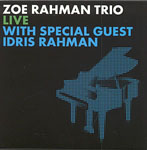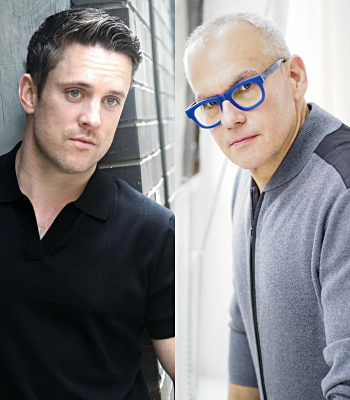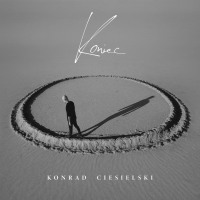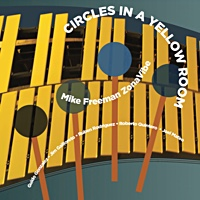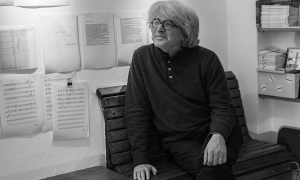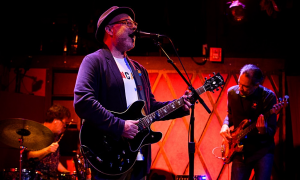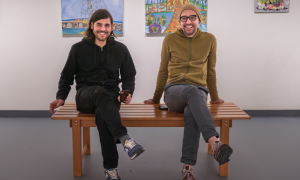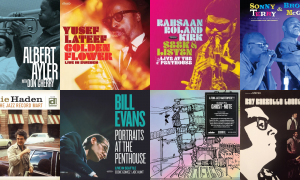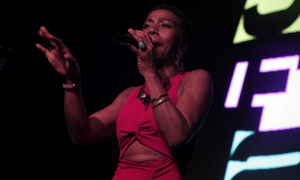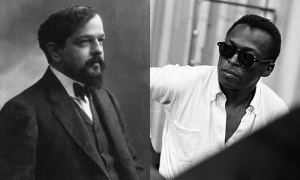Home » Jazz Articles » Interview » Jon Hassell: Fourth World and Balancing the North and South of You
Jon Hassell: Fourth World and Balancing the North and South of You
Jazz is a musical hybrid. It is the collision of African and American—actually African and European, as translated through an American sensibility.
Bang and Honoré are also the co-Artistic Directors of the increasingly well-known and itself influential Punkt Festival in Norway, a festival that has invited Hassell to attend three out of its four years and considers him to be its godfather. For them—and for every artist named above and countless others—there's a simple truth: while they would, no doubt, still be doing important work, it would be significantly different, without the immense effect of Hassell's unmistakable musical aesthetic.
A Career on the Move
While Hassell is best-known for his gradually evolving Fourth World music—a lifelong pursuit first documented on Vernal Equinox (Lovely Music, 1977), but making its first major international splash on Fourth World Vol. 1: Possible Musics (Editions EG, 1980) and Fourth World Volume Two: Dream Theory in Malaysia (Editions EG, 1981), and evolving over the next three decades to the enigmatically named Last night the moon came dropping its clothes in the street (ECM, 2009)—he began his musical life in the company of minimalist progenitors La Monte Young and Terry Riley. He was one of the performers, in fact, on Riley's first (and, many feel, definitive) version of his classic, In C (CBS, 1968).Before Hassell made the trumpet his primary focus—one uniquely colored by a combination of distinctive embouchure and electronic processing; still a trumpet, to be sure, but one that transcends all natural definitions to sound completely otherworldly—he was involved in creating electronic music like the sound sculpture "Solid State," which he performed for only the twelfth or so time since its inception, at Punkt 07. "That was the early '70s," says Hassell, "based on my knowledge of Terry [Riley], and the fact that there was an early Moog in the electronic studio there [State University of New York, in Buffalo]. So I made that piece, "Solid State," and at first I had these sounds going [sings] ba-ba-ba-pi, ba-ba-ba-pi, ba-ba-ba-pi, ba-ba-ba-pi— à la [Philip] Glass, [Steve] Reich, etc. And then Terry gave me the inside story on where Steve Reich came from in terms of his being influenced by—or appropriating, shall we say—certain parts of Terry's music back in San Francisco before they came to New York. So Terry said, "Yeah, that sounds like Steve Reich" or something.
"I was angry about that," Hassell continues, "so I said, 'Okay, I'm just going to make it all sustained and then I'm going to carve out the frequencies with a voltage control filter, using the Moog.' So I started doing that piece as a sound sculpture. Billing makes a difference. If you present it as a sound sculpture then people listen to it from a different way than if it were called music, so I did some things like that."
The past few years have seen a remarkable upsurge in activity for the seventy-something Hassell. In addition to performing with the regularly shifting line-up of his Maarifa Street group, he is a member of Norwegian keyboardist/composer Jon Balke's Siwan project, which performed at Mai Jazz 2008 in Stavanger, Norway and will have a CD released on ECM in 2009; has been appearing with Eno for what they call a "conversational remix"—a means to discuss, in public, ideas that the two are working on for two separate books, with Hassell's titled The North and South of You; has created a sound installation using church bells in Kristiansand, Norway as part of Punkt 08, called NEAR FAR; and has completed a choral work, commissioned by the Norfolk & Norwich Festival.
Public Conversation Pieces with Brian Eno
Hassell and Eno's friendship and collaborative partnering dates back 30 years, but their "conversational remix" at Punkt 08 was the first time the two appeared onstage together to discuss their largely coinciding views of life, the universe and everything. "We're continuing with what it's called now, a 'conversation piece.' It's not just the conversation; when I delve into it, it means another round at culling out the burrs and the curds and the whey from the book, and trying to move it to some other level. The fact is that things move so rapidly in this YouTube-ish world that we're in, and when something that happens live, I presume it will get reported. There's even talk of webcasts. I'm not sure that's actually happening. The short thing I'm saying is that I kind of wish that we would carry this on in a more aggressive manner, that is to say, a college tour, that kind of thing. Brian is withholding a little bit from that because he's a bit burned out and wants to reserve some [energy] to work on whatever his book is going to be."The two set up on a stage with a couple of chairs, an overhead projector and sheets of paper that are spread around the floor of the stage, they both referenced various pages of text which act as catalysts for the two to shed light on their shared philosophy, one that each articulates differently but which ultimately comes down to a shared idea that there's a disconnect between head and heart. Hassell's The North and South of You references the dichotomy between the first and third world countries largely divided by the equator, and the equal split between the intellectual and the sensual, with the equator being the waist of the body. Eno's working title is Surrender which speaks to the idea of surrendering gracefully and becoming a part of something rather than controlling it, with his paradigm of north at one end and south at the other representing the opposing impulses of control and surrender.
"The idea is," Hassell says, 'hey, let's do the book tour before the book and let's do it with two personalities that can actually get enough attention—weight it towards Brian's attention-getting capabilities, so it could actually fly as a bit of performance art mixed with whatever else. We're living in the new Obama time," concludes Hassell, "when everything seems possible. And I just think it seems like a worldwide teachable moment right now that needs to be attacked as in carpe diem. And I'm hoping to convince Brian that we should go that way with it, because the ultimate result is a book or books, because of the documentation.
Hassell and Eno first intersected in the late-'70s, when Eno attended a Hassell concert in New York. "He [Eno] came to a concert I did at The Kitchen [in New Yorkl], a solo concert with somebody doing the loop thing," Hassell explains. It was my debut, if you will, in New York. And so Brian was there and then we spoke afterwards, he introduced himself and said he'd been listening to Vernal Equinox over and over and thought we should get together. So we started hanging out socially. And then he also was working with David Byrne at that time, The Talking Heads, and the time was Remain in Light (Sire, 1980). So we all started to hang out a bit together. We'd go to James Brown concerts together or go to see Brazilian movies.
So that's how I met Brian," Hassell concludes. "The years have passed and I'm the godfather to Brian's daughters, so we have a strong personal connection."
Touring in 2009 with Maarifa Street
Along with the book and his conversational pieces with Eno, the most important things on Hassell's mind at the moment are Last night the moon came—his first recording for ECM since 1986's outstanding Power Spot—and his first major North American tour in many years, which wrapped up in February, 2009. This incarnation of Maarifa Street featured, in addition to Hassell on trumpet and keyboards, long-time musical partner, bassist/laptop player Peter Freeman, Jan Bang utilizing samples and live sampling—which involves recording snippets of music being played, and sending it back to the group, often considerably altered through processing, all in real time—Dino J.A. Deane, also on sampler/live sampling, and extraordinary violinist Kheir-Eddine M'Kachiche (nicknamed Kem, for short). "In general the concerts went really, really well and I'm very happy that we did it," says Hassell. "It was a real administrative grind to get through it all and to go through the visa problems with Kem—he's from Algeria, and then Arnaud [Mercier], the technical director without whom nothing happens, is from Nice, [France]. He had a visa problem, and so it was incredibly costly and time-consuming to mount the thing. But musically speaking it was really, really good."This was a slightly different group than the one that played only a few months earlier at Punkt 08, where instead of Deane, Hassell recruited remarkable Iranian percussionist Pedram Khavarzamini who, along with Kem, Hassell first met with Siwan. "He's a great drummer," Hassell explains, "but it just didn't work out. The economics of touring require you to pack as much power into one person as you can. So I [recruited] J. A. Deane, who I had recently come into contact with after an absence of many, many years. He was on Power Spot and a lot of the records from that epoch. So I had two live samplers, kind of symmetrical on the stage, and Peter, [Kem] and myself. So it was five onstage."
As good as Hassell feels about the tour—a feeling that was shared by his audiences in cities ranging from New York and Philadelphia, to Los Angeles and Vancouver, Canada—he's always searching for ways to refine the process. It's why, with only a couple of minor detours, his entire discography reflects a singular, albeit stylistically broad, musical vision that continues to evolve with every passing year. "I remember the concert in Punkt," Hassell recalls, "it was a very slow start for me. And if you're totally committed to the idea of closing your eyes and tripping, okay; no problem. But I personally need to use my own yardstick for what keeps the attention level high. So I'm always trying to, in a sense, splice or "edit" from every live experience we have because I think, 'Don't be so tentative. Make your statement, say it.' If it's wrong then we'll know.
"I guess I've delivered enough nasty looks," he continues. "I'm not a mouse onstage so I guess I've made my unhappiness clear at such points so that musicians often try to please me, so to speak. And sometimes that's a problem. I also appreciate someone who is their own personality. Obviously there's got to be some merging with the kind of musical culture that I've built up over the years. Herbie Hancock called me from Sweden a few months ago. He was visiting Peter Johansson, a drummer that he played with before, and [who] had played some with Maarifa Street, and he called me from there and said, 'You know, I really like this.'
"So we made noises about getting together sometime," Hassell continues, "and what brings it to mind is that with someone who has a long career and long roots and all that, that's not the kind of person that would [necessarily] fit in the situation as a musician. I mean obviously if I did something with Herbie it would be quite different, a different mold. I'm only making the point here about the fact that if someone who has a well-formed profile comes into the group, then that's a problem too. So sometimes it's a delicate balance between spontaneity and forthrightness. I think everybody knows when it's good; that's my assumption, that everybody knows when it's good. And, in fact, that's really the key—to just tell yourself constantly what it is that you really like.
"It's that page from the book that I spoke about in Kristiansand [in 2008]," Hassell concludes, "that says: 'You let the things that you're supposed to like—or the thing that your peers tell you you're supposed to like or all the givens that you have grown up and grown through and come out of—and not make the mistake of rejecting all of them out of hand.' Some of [those] givens may be things that you really do like. And those are the ones that you should welcome, that you should accept."
Hassell's music is defined by gradual evolution; tracks like "Abu Gil," from Last night the moon came, unfold slowly, almost painstakingly, with clear motifs (in this case a reference to Duke Ellington's "Caravan" and Gil Evans' rich approach to orchestration). Still, as hypnotic as Hassell's music is—perhaps the most successful marriage of head and heart, as music for the mind that still resonates on a deeply emotional, deeply physical level—Hassell is constantly looking for ways to hone it, and avoid the risk of excessive meandering.
"I see my whole progression in terms of just winnowing out the things that I don't really like," Hassell explains. "I don't hold back about what I feel about things like that. Naturally I have to be polite if I'm talking to other people or talking about other peoples' work. But when I say, 'I'm sorry, I'm bored here,' I'm very quick to say that about my own output. And when I try to make the band function that way I say: 'Listen to this, these two minutes here, where we could have gotten from point A to point B without going through this tentativeness.' I don't want to lean on some kind of, 'Oh, it's space music and you're just supposed to trip out and imagine wherever your imagination goes.' I am perfectly happy to not be criticized by people in that state. I'd probably hate it if it was a music critic that was writing that about me. If I were completely honest, I'd be saying: 'Here's something that's not moving fast enough for me,'" and there's stuff on the record that I would change now.
"The live performances are often, I think, better than the record—sometimes not," Hassell continues. "But certainly having those forces, that is to say, the two live samplers, the real point is to say, 'Look, let's keep this wide open, not just because you're there. Think of it as—I was going to say conversation, but it's maybe more like a ceremony, and you only interject whenever [you] feel like it. The model that's coming in my mind now is the Black church. When someone is saying the right thing or singing the right thing, the words are, 'Yes, Lord! Yeah! Amen!' That kind of spontaneity is so great in that tradition.
"And so I'm saying to the live samplers, 'Okay, be careful,'" Hassell concludes. "Jan has it down and then Dino, because Jan has played it before—he was the one on the record. That piece [the title track] actually began when we were in the studio in Provence [Studios La Buissonne]. The origin was that I said, 'Okay, now let's just turn things upside down; let's slow down, let's take a few of the elements out of "Maarifa Street"—I'm talking about the tune now, not the group [from the album Magic Realism 2 (Nyen, 2005)]—let's take a few elements out of that menu and apply them in a way so that we turn this in a way, [and] make it not recognizable at all."
Is It Jazz? Does It Matter? A History of Fourth World
Like so many musicians today, in a landscape where it's increasingly clear that having roots in the jazz tradition does not necessarily mean actually playing with strong references to that tradition, Hassell's Fourth World music has grown out of a rich, multidisciplinary background that brings together influences from an expanding range of cultural sources, the ever more sophisticated capabilities that modern technology permits and a fervent desire to appeal to both the head and the heart—The North and South of You. "The word 'jazz' was never mentioned," Hassell enthuses. "I'm so pleased that The New Yorker just picked it up out of nowhere; it was a little review of the record and a preamble to the concert at Zankel Hall. And I said, 'Imagine that someone was reading this, knowing it came from these places and the word jazz was never mentioned. I'd feel a lot of curiosity about it.' If the word jazz entered into it, I can imagine that the unknown person reading it would automatically [have] a whole picture of it—a whole gestalt of things would come to mind that would prevent them from being more curious about it."When you hear the word 'jazz,' immediately you've got a certain connotation," Hassell continues. "If you're not on the inside and know that it's a much broader category, you're just kind of like, 'Oh yeah, I've been there, done that.' If a piece were played on a classical station, saying 'This is the new Phillip Glass,' or the new this-or-that, of somebody from that world, I think it would be accepted, number one; and it would be a whole [different] group of listeners who could be enticed to buy the record, number two.
"I look at it this way," he continues. "First of all, I grew up in America. I grew up where jazz comes from. It's in the air and in the bloodstream. But if I were looking at the world's music from a more objective viewpoint—outer space or something—I'd say: 'Well, jazz is this music over here. And so to leave it out, if I'm really listening to all the flavors, let's say, from all the places, then to leave that out would be crazy. First of all, it's in my bloodstream. And jazz, itself, is a hybrid, a musical hybrid. It is the collision of African and American—actually African and European, as translated through an American sensibility. So that's why the references are there, and the general feeling of latter-day jazz manifestations à la Gil Evans and Miles.
"At the same time," Hassell continues, "it was a strange learning process for me—I think I've used the phrase before about parachuting into the jazz world and not having hacked my way through the jungle to whatever center there might be. When I studied, I'm in Memphis, I hear things, I'm blown away as a kid by hearing Stan Kenton and the big improvising orchestra coming—a string section, five trumpets, five trombones, five saxophones, with Maynard Ferguson screaming on top. That was the most thrilling thing I'd ever heard in my life. Not that I didn't know—my parents would let me drive the car if I would go to church on Sunday. But what I'd do is just park and listen to the radio. And I remember Kenton coming on, and I thought, 'Wow! This is amazing. I've never heard this before.'
"So I have a much longer treatise to write about," continues Hassell, "in some sense, what it is that presets an ear—our sensibility to listen to big, thick chords; to the lush harmonies that came via [Maurice] Ravel, [Claude] Debussy and Impressionism, coming through people like Gil [Evans] and the tradition of using it and translating it in urban terms, the harmonic language of Impressionism. So I've come up through that, I go to school, I'm in Eastman School of Music, I'm studying orchestral trumpet playing, orchestral excerpts and trying to learn "Petrushka" solos and things like that, and [Igor] Stravinsky, at least 'Histoire du soldat.' And I'm kind of slated towards orchestral playing. But then I'm a composer, I'm not really there for trumpet; I'm there in composition basically. Actually, at that point, it was probably for both.
"So I'm in the kind of wild wing of composition," Hassell concludes, "Eastman Music was not exactly a hotbed of revolutionary activity, so we were the ones that were listening to [Anton] Webern and [Arnold] Schoenberg—all the 12-tone guys and all that. So then I get married, I have to go in the army. I go in the army band in Washington. I study musicology and get everything up to a Ph.D. in musicology, like going over to the Library of Congress and translating Gregorian Chants. Then I started reading these magazines from Europe—The Rogue, in German, that [Karlheinz] Stockhausen put out—all the articles about Stockhausen and Luciano Berio. And I start making little electronic collages because I hear Stockhausen's early etudes—the earliest electronic music on Deutsche Grammophon."
In the context of this intrepidly experimental environment, Hassell would come to a concept that would affect everything to come. "So I started making little things with tapes and collages," Hassell describes. "I remember one of the first things I ever did was to take a big thick chord sung by the Hi-Lo's, and kind of slice up that chord—we're talking splicing tape here—and making a cubist mash-up of the chord. Call it early sampling, when you're basically just recording a piece of something and with tape manipulation you're playing around [with it].
"So I go off to Europe, where I studied with Stockhausen for a couple of years," Hassell continues. "My wife was a pianist and she falls into that scene of playing Stockhausen at recitals and things like that. In the meantime, someone brings over The Beatles and says, 'Hey, listen to this, this is cool.' One of the scores I did was to take a Schoenberg piece and chop it up and have these little electronic devices—basically mixes that had a little keyboard on it so that the players were playing this sample of altered strings as softly as they could (you couldn't hear them on stage without amplification), so every time somebody plays the keyboard or hits one of the little nodes on the keyboard, then suddenly what they were playing would come to the fore.
"I learned a lot from Stockhausen, in terms of listening to sound and notating things," concludes Hassell. "One of the exercises he used to give us was to play little bursts of shortwave radio with all the static and noise and everything and say, 'Notate it in terms of statistical methods.' You're talking about a string section and you've got 20 players and you say, 'Everybody play these notes pizzicato, at this rate: 10 within 1 second or 10 within 10 seconds,' or something like that. They're like textural composition, and so I get behind where all the notes are coming from with Stockhausen. Then I come back to State University of New York at Buffalo where there was a thing called Center for the Creative and Performing Arts. And Lukas Foss, who recently passed away, was the head of that. And the thing there was to be a composer and a performer. You had to have both."
Following the composition of "Solid State," an unexpected experience in Rome substantially changed Hassell's world view. "Lamonte Young and I did a performance in Rome and I heard [Indian vocal master Pandit] Pran Nath warming up. He was also doing a concert in the series there. I was warming up, I was playing these patterns; I had been sort of experimenting with a wah-wah pedal and all that, à la Miles from that period [early '70s]. And I was playing these patterns and Pran Nath heard me warming up; and so I heard him and he heard me and he took these patterns and started spinning them off. And I thought, 'Wow! That's cool.' So then I started studying. Raga was just raga to me. It was music from another place and I had no idea of how it was formed and shaped and what the ethos of it was. So then I started studying. I started studying with the trumpet, first singing and then trying to apply it to trumpet. Basically I had to pull away and kind of unlearn everything and start from there."
From unlearning old habits to innovating new ones, Hassell deserted strict composition and focused on active performance—and the creation of the building blocks for Fourth World music. "David Rosenboom, who is now the dean of music at Cal Arts, was another of the fellows at the Center for Creative and Performing Arts in Buffalo," says Hassell. "He had since become director of the electronic music studio at New York University and he invited me to come there and do something. So I went there and that's when we did Vernal Equinox with the people that were around at that point. That's when I met Michael Brook, the technician in the studio. He played guitar also, so then I started developing that he would be engineer on Vernal Equinox.
"I tried to apply this raga thing and the trumpet stuff that I had learned," concludes Hassell, "pulling in things around me that—instead of the tambura, [I used] an electronic drone, for example, and using a different kind of drumming along with it, which is what Vernal Equinox is. We did a concert in the Art Gallery of Ontario, I think it was, with Michael, who had since come on stage and started playing combinations of mixing live and playing guitar. And so he would grab a second or so with this early [Lexicon] Prime Time [delay] and throw it back into the mix. That is 'Griot (Over "Contagious Magic")'—it's a little four-minute piece, and I think it's probably the first live sampling, though I'll leave that to the music historians."
Vernal Equinox was Hassell's first Fourth World album, but his trumpet tone—a mix of almost shakuhachi-like richness/air and harmonizing that gave it vertical depth—evolved in leaps and bounds by the time he began to work with Brian Eno and a young Daniel Lanois, at Lanois' Hamilton, Canada Grant Avenue Studio.
Eno and Hassell found themselves at Grant Avenue Studio mainly because it was cheap—though as a result of an enticing hourly rate, Lanois quickly made a name for himself and forged a relationship with Eno that continues to this day as a mega-producer for artists including U2, Peter Gabriel, Bob Dylan and Neville Brothers, not to mention a string of fine solo albums including Acadie (Red Floor, 1989) and, more recently, Here Is What Is (Red Floor, 2007). Hassell recorded Dream Theory In Malaysia there, the follow-up to Possible Musics, which thrust Hassell into a greater spotlight. Both discs shook the world of those who were listening—a significant evolution over Vernal Equinox and, even more, Earthquake Island (Tomato, 1979), which teamed Hassell with more clearly defined jazz musicians including bassist Miroslav Vitous, guitarist Ricardo Silveira and percussionists Dom Um Romao and Nana Vasconcelos for something that, while still part of Hassell's overall oeuvre, was more overtly ethnic than anything that had come before, or would follow after.
Still, the innovations of Vernal Equinox continue to be part of Hassell's musical palette, even to this day. "On the title piece [to Vernal Equinox, I was] coming fresh off of a lot of this raga thing that I was trying to do when I was in exile in California," explains Hassell. "And so I am playing a lot of bendy things and kind of raga lines and things that I don't really do anymore. I'm not so tuned into that anymore, but I can still pull it out of the box and make a few little moves in that direction, but as far as consistently trying to be raga-like, which is also on Possible Musics on the track called 'Charm (Over "Burundi Cloud").' And I was a lot more into that then.
"Brian may have been working on other things of his own too [while Hassell was working on Possible Musics, which was recorded in New York at Celestial Sounds], "continues Hassell. "So it was more like my being given my free rein to hang myself—given enough rope to hang myself or not. So that's much more my kind of quirky hand in those projects—willful entrance in the process and playing on various things.
"This goes back to the jazz thing now," he continues, "the fact that I learned about shape-making. It's what raga is about; it's about making a beautiful shape in air. I call it calligraphy in sound. So that opened my eyes to things that I'd merely appreciated before, from a vibe point of view. Now, when I hear a Johnny Hodges solo or a Jimmy Scott phrasing of Joao Gilberto phrase or something like that, I think about this idea of shape-making, an obvious connection to Hodges, whose solos are like they are being squeezed out of a tube of toothpaste. Everything is connected; all the microtonal shape-making and everything that belongs to raga.
"Even at Eastman I was listening to African music," he continues, "and went further into that, becoming familiar with Pygmy music and Gamelan—my sort of three-legged stool: raga, Pygmy and Gamelan, that showed up on Aka-Darbari-Java (Editions EG, 1983). So I'm seeing my connection to jazz as from this kind of fugal lens, after having been brought up in the cradle of it, so to speak, and having it in my ears and in my blood, as a kind of external thing. I wasn't trying to be Charlie Parker and I wasn't trying to be Miles, really. Although at one point I probably would have accepted that.
"Then I came to the stages like passing through the educational formations," Hassell concludes. "It's like passing through this formation stage and then seeing those other things. Seeing jazz from that point of view made me appreciate all the subtlety of other kinds of music—it didn't make any difference whether it was labeled classical or popular or blues or jazz or whatever the label was. It just makes you look at everything through that lens. So I am very, very close to—just to bring it right down home—what have I been listening to in the last few days, almost constantly."
Hassell's music may not speak the language of jazz directly, but it possesses its spirit, and he continues to listen to it as a reference source to evolve his own music, which is imbued with a sensual quality that's hard to deny. "A friend of mine in Germany—Karl Lippegaus, who does these great radio shows mixing classical and popular and everything—sent me this 1981 recording of [Antonio Carlos] Antonio Carlos Jobim, who was about 54 at that time, playing solo and singing, just him and his piano, singing in the Belo Horizontes in Brazil, singing all these great Brazilian songs that we've all come to know, like the so-called 'Girl from Ipanema' and 'Desafinado,' which have these incredible lyrics that no one really knows about. I've been listening to that almost continually for the last couple of days. And I'm thinking, what is there about these things that I love—why can't I do some of this? And I've been very ballsy earlier before about making some point and early in the Marial Festival invitation they asked what I'd like to do and I actually mentioned, 'Gee, it would be great if I could do something with Joao Gilberto.' I hope it happens. I love Mariel and I love the festival—I love being there."
The Rhythm of the Groove
Peter Freeman has been an instrumental part of Hassell's seeming reemergence in recent years (though the trumpeter truly never really went anywhere). The Los Angeles-based bassist first collaborated with Hassell on the final track to Dressing for Pleasure (Warner Bros., 1994)—a track which, with its thick, sensual groove and darker textures, was in sharp contrast to Hassell's most overtly booty-shaking album, and one that would pave the way for the Maarifa Street group and its debut, Magic Realism 2, after a detour with the all-acoustic, Ry Cooder-produced Fascinoma (Water Lily Acoustics, 1999) where, while Hassell continued to explore his Indian roots with bansuri flautist Ronu Majumdar-Bansuri, he did so filtered through his own jazz prism, with unique takes of "Nature Boy," "Poinciana" and variations on Ellington's "Caravan.""That was the first thing we [Hassell and Freeman] did together, that "Blue Night" bonus track at the end of Dressing for Pleasure," says Hassell. "Actually I got a lot more raw, more interesting things than actually came out on that record because I had had a guide into the netherworld of early hip-hop. There are lots of little secret things in that record. But yeah, that was the first thing that we did together and he certainly has changed things and moved things in a certain direction.
"It has been a bit of a good-natured struggle," Hassell continues, "in this recent situation, with two or three of the tracks [on Last night the moon came] coming from a concert we did in London just before we actually finished the mastering, with [drummer] Helge Norbakken and also Steve Shehan, another great, great drummer. I cut out some of Helge because what happens in general is, when bass and drums get together they lock in and start going someplace. I actually resist that groove thing because in a way it's so easy to do. And there are many little chips around with grooves already built into them, you only have to push a button to get it.
"And so it's kind of like inflation has come and the groove is not worth very much to me musically anymore," says Hassell. "And what's a groove to me is Pygmy or other forms of African drumming, where there's not an even division between the 8th notes and the cues are being had off of like, 'Oh, he hit that there, now I do this'—that kind connective; that sinew, that muscle of the rhythm—something which is always changing and beautiful. I'll do that for sure. But in terms of just kind of like metronomic grooving, I have to resist that. I think south of the border is one of the great places if you're going for groove, so I've encouraged Peter to be much more out of the metronomic background, as we can change the message to fit the groove.
"We'd sample these African hair drums that we carried with us, put it down an octave and then put these little pads and cork on sheet metal pads in the middle of the drum set and that would become the mixture," Hassell continues. And so Deano [J.A. Deane] would play and record patterns. It wouldn't just be like one hit and play it down an octave. It would be a little thing like [sings] 'be-ba-ba-bom.' And so that pattern would be worked into the rhythm but it wouldn't be necessarily metronomic. I'm just hearing where things fall for me, which is often not where the upbeat is; I'm just not feeling it that way. It doesn't have to be on the 'one'; that straightens out the curves and the curves are what makes it interesting. So there's been a big push for that.
Recording Last night the moon came dropping its clothes in the street for ECM
While Power Spot was a fully finished album that was picked up by ECM, Last night the moon came represents the first time Hassell worked directly with the label—and label head/producer Manfred Eicher—on a project.Tags
PREVIOUS / NEXT
Support All About Jazz
 All About Jazz has been a pillar of jazz since 1995, championing it as an art form and, more importantly, supporting the musicians who make it. Our enduring commitment has made "AAJ" one of the most culturally important websites of its kind, read by hundreds of thousands of fans, musicians and industry figures every month.
All About Jazz has been a pillar of jazz since 1995, championing it as an art form and, more importantly, supporting the musicians who make it. Our enduring commitment has made "AAJ" one of the most culturally important websites of its kind, read by hundreds of thousands of fans, musicians and industry figures every month.




